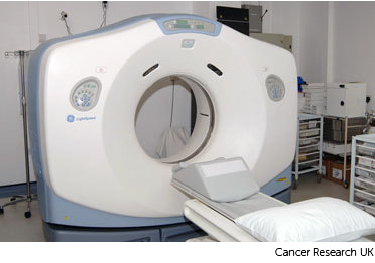Planning radiotherapy
Before you have treatment, the radiotherapy team plans your external beam radiotherapy. This means working out the amount (dose) of radiotherapy you need and exactly where you need it.
There are 2 main types of radiotherapy, external and internal radiotherapy (brachytherapy). You usually have external radiotherapy for non melanoma skin cancer. But in some cases your doctor might use brachytherapy, although this is less common.
Planning your treatment
Your planning appointment takes from 15 minutes to 2 hours.
You usually have a planning CT scan in the radiotherapy department.
The scan shows the cancer and the area around it. You might have other types of scans or x-rays to help your treatment team plan your radiotherapy. The plan they create is just for you.

Your radiographers tell you what is going to happen. They help you into position on the scan couch. You might have a type of firm cushion called a vacbag to help you keep still.
The CT scanner couch is the same type of bed that you lie on for your treatment sessions. You need to lie very still. Tell your radiographers if you aren't comfortable.
Injection of dye
You might need an injection of contrast into a vein in your hand. This is a dye that helps body tissues show up more clearly on the scan.
Before you have the contrast, your radiographer asks you about any medical conditions or allergies. Some people are allergic to the contrast.
Having the scan
Once you are in position your radiographers put some markers on your skin. They move the couch up and through the scanner. They then leave the room and the scan starts.
The scan takes about 5 minutes. You won't feel anything. Your radiographers can see and hear you from the CT control area where they operate the scanner.
Ink and tattoo marks
The radiographers make pin point sized tattoo marks on your skin. They use these marks to line you up into the same position every day. The tattoos make sure they treat exactly the same area for all of your treatments. They may also draw marks around the tattoos with a permanent ink pen, so that they are clear to see when the lights are low.

The radiotherapy staff tell you how to look after the markings. The pen marks might start to rub off in time, but the tattoos won’t. Tell your radiographer if that happens. Don't try to redraw them yourself.
Moulds or masks
If you are having treatment to your head or neck, you may need to have a mould (shell) made to keep you perfectly still while you have treatment.

You may also have a mould if you have to keep an arm or leg still. Sometimes moulds are made for around the body to help you keep still.
The moulds are made in the mould room or in the CT scanning room.
Radiotherapy to delicate areas
Your treatment team might use lead shields to protect delicate areas such as the eyes, nose or lips. The lead shields are only put in place when you're actually having treatment.
After your planning session
It can take a few days or up to 3 weeks before you start treatment. During this time your radiologists and doctors create your radiotherapy plan.



